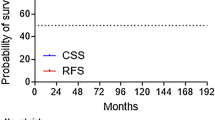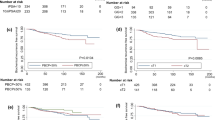Abstract
Background
Although the optimal management of locally advanced prostate cancer (PCa) remains unclear, local definitive therapy, thus combined radiotherapy and androgen deprivation, is one option. We evaluated the long-term outcomes of patients with locally advanced PCa who underwent high-dose-rate brachytherapy (HDR-BT) and external beam radiation therapy (EBRT).
Methods
We retrospectively analyzed 173 patients with locally advanced PCa (cT3a-4N0-1M0) who underwent HDR-BT and EBRT. We employed Cox’s proportional hazards models to identify pre-treatment predictors of oncological outcomes. Treatment outcomes (biochemical recurrence-free survival [BCRFS], clinical progression-free survival [CPFS], and castration-resistant prostate cancer-free survival [CRPCFS] were compared according to the combination of the pre-treatment predictors.
Results
The 5-year BCRFS, CPFS, and CRPCFS rates were 78.5, 91.7, and 94.4% respectively; there were two PCa deaths. Multivariate analysis revealed that the clinical T stage (cT3b and cT4) and Grade Group (GG) 5 status were independent risk factors for poor BCRFS, CPFS, and CRPCFS. In the GG ≤ 4 group, the Kaplan–Meier curves for BCRFS, CPFS, and CRPCFS revealed excellent outcomes. However, in the GG5 group, patients with cT3b and cT4 PCa evidenced significantly poorer oncological outcomes than those with cT3a PCa.
Conclusion
The clinical T stage and GG status were significantly prognostic of oncological outcomes in patients with locally advanced PCa. In patients of GG ≤ 4 PCa, HDR-BT was effective even in patients with cT3b or cT4 PCa. However, in patients with GG5 PCa, careful monitoring is essential, particularly of patients with cT3b or cT4 PCa.



Similar content being viewed by others
Data availability statement
The data that support the findings of this study are available from the corresponding author upon reasonable request.
References
Cooperberg MR, Broering JM, Carroll PR (2010) Time trends and local variation in primary treatment of localized prostate cancer. J Clin Oncol 28(7):1117–1123
Mottet N, Bellmunt J, Bolla M et al (2017) EAU-ESTRO-SIOG guidelines on prostate cancer. Part 1: screening, diagnosis, and local treatment with curative intent. Eur Urol 71(4):618–629
Kishan AU, Cook RR, Ciezki JP et al (2018) Radical prostatectomy, external beam radiotherapy, or external beam radiotherapy with brachytherapy boost and disease progression and mortality in patients with Gleason score 9–10 prostate cancer. JAMA 319(9):896–905
Imai Y, Urabe F, Iwatani K et al (2023) Comparison of outcomes in high-risk prostate cancer patients treated with low-/high-dose-rate brachytherapy plus external beam radiotherapy. Int J Clin Oncol. https://doi.org/10.1007/s10147-023-02314-0
Ishiyama H, Satoh T, Kitano M et al (2014) High-dose-rate brachytherapy and hypofractionated external beam radiotherapy combined with long-term hormonal therapy for high-risk and very high-risk prostate cancer: outcomes after 5-year follow-up. J Radiat Res 55(3):509–517
Makino T, Nakashima K, Iijima M et al (2019) Health-related quality of life and toxicity after single-fraction high-dose-rate brachytherapy with external beam radiotherapy for localized and locally advanced prostate cancer. Anticancer Res 39(1):477–486
Kasahara T, Ishizaki F, Kazama A et al (2020) High-dose-rate brachytherapy and hypofractionated external beam radiotherapy combined with long-term androgen deprivation therapy for very high-risk prostate cancer. Int J Urol 27(9):800–806
Yamazaki H, Suzuki G, Masui K et al (2022) Role of brachytherapy boost in clinically localized intermediate and high-risk prostate cancer: lack of benefit in patients with very high-risk factors T3b–4 and/or Gleason 9–10. Cancers (Basel) 14(12):2976
Mori K, Sasaki H, Tsutsumi Y et al (2021) Trimodal therapy with high-dose-rate brachytherapy and hypofractionated external beam radiation combined with long-term androgen deprivation for unfavorable-risk prostate cancer. Strahlenther Onkol 197(11):976–985
Roach M 3rd, Hanks G, Thames H Jr et al (2006) Defining biochemical failure following radiotherapy with or without hormonal therapy in men with clinically localized prostate cancer: recommendations of the RTOG-ASTRO Phoenix consensus conference. Int J Radiat Oncol Biol Phys 65(4):965–974
Scher HI, Morris MJ, Stadler WM et al (2016) Trial design and objectives for castration-resistant prostate cancer: updated recommendations from the prostate cancer clinical trials working group 3. J Clin Oncol 34(12):1402–1418
Yamazaki H, Suzuki G, Masui K et al (2021) Radiotherapy for clinically localized T3b or T4 very-high-risk prostate cancer-role of dose escalation using high-dose-rate brachytherapy boost or high dose intensity modulated radiotherapy. Cancers (Basel) 13(8):1856
Makino T, Sakurai T, Takamatsu S et al (2021) The effectiveness of high-dose-rate brachytherapy with external beam radiotherapy for clinically locally advanced and node-positive prostate cancer: long-term results of a retrospective study. Int J Clin Oncol 26(12):2310–2317
Tsumura H, Ishiyama H, Tabata KI et al (2017) Impact of five-tiered Gleason grade groups on prognostic prediction in clinical stage T3 prostate cancer undergoing high-dose-rate brachytherapy. Prostate 77(15):1520–1527
Hegde JV, Demanes DJ, Veruttipong D et al (2017) Pretreatment 3T multiparametric MRI staging predicts for biochemical failure in high-risk prostate cancer treated with combination high-dose-rate brachytherapy and external beam radiotherapy. Brachytherapy 16(6):1106–1112
Tharmalingam H, Tsang Y, Choudhury A et al (2020) External beam radiation therapy (EBRT) and high-dose-rate (HDR) brachytherapy for intermediate and high-risk prostate cancer: the impact of EBRT volume. Int J Radiat Oncol Biol Phys 106(3):525–533
Sundi D, Tosoian JJ, Nyame YA et al (2019) Outcomes of very high-risk prostate cancer after radical prostatectomy: validation study from 3 centers. Cancer 125(3):391–397
Kuban DA, Levy LB, Cheung MR et al (2011) Long-term failure patterns and survival in a randomized dose-escalation trial for prostate cancer. Who dies of disease? Int J Radiat Oncol Biol Phys 79(5):1310–1317
Sabolch A, Feng FY, Daignault-Newton S et al (2011) Gleason pattern 5 is the greatest risk factor for clinical failure and death from prostate cancer after dose-escalated radiation therapy and hormonal ablation. Int J Radiat Oncol Biol Phys 81(4):e351–e360
Kimura S, Abufaraj M, Janisch F et al (2020) Performance of [68Ga] Ga-PSMA 11 PET for detecting prostate cancer in the lymph nodes before salvage lymph node dissection: a systematic review and meta-analysis. Prostate Cancer Prostatic Dis 23(1):1–10
Patel SA, Baumann B, Michalski J et al (2023) Association of brachytherapy boost with overall survival for Gleason 9–10 prostate cancer: the impact of primary versus secondary pattern 5. Brachytherapy 22:310–316
Rosenthal SA, Hu C, Sartor O et al (2019) Effect of chemotherapy with docetaxel with androgen suppression and radiotherapy for localized high-risk prostate cancer: the randomized phase III NRG oncology RTOG 0521 trial. J Clin Oncol 37(14):1159–1168
Martell K, Kollmeier MA (2021) Complications and side effects of high-dose-rate prostate brachytherapy. Brachytherapy 20(5):966–975
Acknowledgements
The authors thank Textcheck Inc. for English language editing.
Author information
Authors and Affiliations
Corresponding author
Ethics declarations
Conflict of interest
The authors declare that there are no conflict of interests.
Additional information
Publisher's Note
Springer Nature remains neutral with regard to jurisdictional claims in published maps and institutional affiliations.
Supplementary Information
Below is the link to the electronic supplementary material.
About this article
Cite this article
Kadena, S., Urabe, F., Iwatani, K. et al. The prognostic significance of the clinical T stage and Grade Group in patients with locally advanced prostate cancer treated via high-dose-rate brachytherapy and external beam radiation. Int J Clin Oncol 28, 1092–1100 (2023). https://doi.org/10.1007/s10147-023-02359-1
Received:
Accepted:
Published:
Issue Date:
DOI: https://doi.org/10.1007/s10147-023-02359-1




